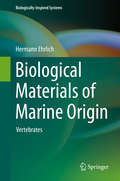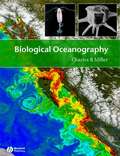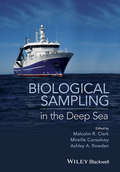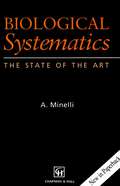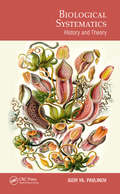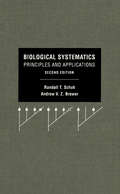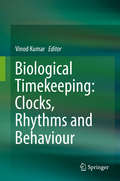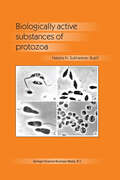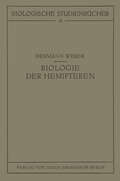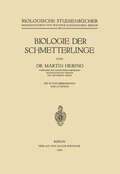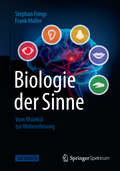- Table View
- List View
Biological Invasions in the South American Anthropocene: Global Causes and Local Impacts
by Fabián M. Jaksic Sergio A. CastroThis book provides a conceptually organized framework to understand the phenomenon of biological invasions at the Anthropocene global scale. Most advances toward that aim have been provided from North American and European researchers, with fewer contributions from Australia and South Africa. Here we fill the void from the Neotropics, focusing on the research experience in South American countries, with a strong emphasis on Argentina and Chile. The text is divided into two parts: The first half comprises self-contained chapters, providing a conceptual, bibliographic and empirical foundation in the field of invasion biology, from an Anthropocene perspective. The second half reviews the ecology, biogeography, and local impacts in South America of exotic species groups (European rabbit, Eurasian wild boar, Canadian beaver, North American mink, and Holarctic freshwater fishes), which are shown to be useful models for case studies of global relevance.
Biological Low-Voltage Scanning Electron Microscopy
by James Pawley Heide SchattenMajor improvements in instrumentation and specimen preparation have brought SEM to the fore as a biological imaging technique. Although this imaging technique has undergone tremendous developments, it is still poorly represented in the literature, limited to journal articles and chapters in books. This comprehensive volume is dedicated to the theory and practical applications of FESEM in biological samples. It provides a comprehensive explanation of instrumentation, applications, and protocols, and is intended to teach the reader how to operate such microscopes to obtain the best quality images.
Biological Materials of Marine Origin: Vertebrates (Biologically-Inspired Systems #4)
by Hermann EhrlichThis is the second monograph by the author on biological materials of marine origin. The initial book is dedicated to the biological materials of marine invertebrates. This work is a source of modern knowledge on biomineralization, biomimetics and materials science with respect to marine vertebrates. For the first time in scientific literature the author gives the most coherent analysis of the nature, origin and evolution of biocomposites and biopolymers isolated from and observed in the broad variety of marine vertebrate organisms (fish, reptilian, birds and mammals) and within their unique hierarchically organized structural formations. There is a wealth of new and newly synthesized information, including dozens of previously unpublished images of unique marine creatures including extinct, extant and living taxa and their biocomposite-based structures from nano- to micro – and macroscale. This monograph reviews the most relevant advances in the marine biological materials research field, pointing out several approaches being introduced and explored by distinct modern laboratories.
Biological Membrane Ion Channels: Dynamics, Structure, and Applications (Biological and Medical Physics, Biomedical Engineering)
by Shin-Ho Chung Olaf S. Anderson Vikram V. KrishnamurthyThis book deals with recent breakthroughs in ion-channel research that have been brought about by the combined effort of experimental biophysicists and computational physicists, who together are beginning to unravel the story of these exquisitely designed biomolecules. With chapters by leading experts, the book is aimed at researchers in nanodevices and biosensors, as well as advanced undergraduate and graduate students in biology and the physical sciences.
Biological Models in Radiopharmaceutical Development (Developments in Nuclear Medicine #27)
by R.M. LambrechtRadiophannaceuticals labeled with short-lived radionuclides are utilized to unravel biochemical processes, and to diagnosis and treat diseases of the living body are-developed through extensive evaluation in ~iological models. 'fhC first attempt to compile information was a volume entitled ANIMAL MODELS IN RADIOTRACER DESIGN that was edited by William C. Eckelman and myself in 1983. The volume had a focus on the animal models that investigators were using in order to design radiotracers that displayed in vivo selectivity as measured by biodistribution and pharmacokinetic studies. A concern in the early days of nuclear medicine was species differences. Often a series of labeled compounds were evaluated in a several different animal models in order to gain confidence that the selected radiotracer would behave appropriately in humans. During the past 12 years there have been remarkable advances in molecular genetics, molecular biology, synthetic radiopharmaceutical chemistry, molecular modeling and visualization, and emission tomography. Biological models can now be selected that are better defined in terms of molecular aspects of the disease process. The development of high resolution PET and SPET for clinical applications facilitates the development of new radiopharmaceuticals by the use of models to quantitatively evaluate drug effects, and progression of disease, and hence to arrive at better diagnosis and treatments for animals and humans. With these advances there is an effective use of biological models, and the refinement of alternatives for the development of new radiophannaceuticals.
Biological Neural Networks: Hierarchical Concept Of Brain Function
by Konstantin V. BaevThis book is devoted to a novel conceptual theoretical framework of neuro science and is an attempt to show that we can postulate a very small number of assumptions and utilize their heuristics to explain a very large spectrum of brain phenomena. The major assumption made in this book is that inborn and acquired neural automatisms are generated according to the same func tional principles. Accordingly, the principles that have been revealed experi mentally to govern inborn motor automatisms, such as locomotion and scratching, are used to elucidate the nature of acquired or learned automat isms. This approach allowed me to apply the language of control theory to describe functions of biological neural networks. You, the reader, can judge the logic of the conclusions regarding brain phenomena that the book derives from these assumptions. If you find the argument flawless, one can call it common sense and consider that to be the best praise for a chain of logical conclusions. For the sake of clarity, I have attempted to make this monograph as readable as possible. Special attention has been given to describing some of the concepts of optimal control theory in such a way that it will be under standable to a biologist or physician. I have also included plenty of illustra tive examples and references designed to demonstrate the appropriateness and applicability of these conceptual theoretical notions for the neurosciences.
Biological Oceanography
by Charles B. MillerThis modern textbook of biological oceanography is aimed at students taking oceanography, marine biology and marine sciences courses. It covers recent developments such as the molecular techniques (including sequence data) that have allowed a re-examination of the ocean's microbial ecology and the role of the various trophic groups in biogeochemical cycling, carbon flow and climate control. Major topics covered include phytoplankton bloom, microbial food web, marine biogeography, global climate change and an overview of fisheries oceanography. Difficult concepts are explained in a straightforward manner, making this book accessible to undergraduates, graduates and researchers alike. Features a chapter on important numerical models which have become indispensable in biological oceanography. Further details of key terms and important topics are highlighted in boxes Models, formulas, methodologies, and techniques are described and explained throughout. An Instructor manual CD-ROM for this title is available. Please contact our Higher Education team at HigherEducation@wiley.com for more information.
Biological Oceanography
by Charles B. Miller Patricia A. WheelerThis new edition of Biological Oceanography has been greatly updated and expanded since its initial publication in 2004. It presents current understanding of ocean ecology emphasizing the character of marine organisms from viruses to fish and worms, together with their significance to their habitats and to each other. The book initially emphasizes pelagic organisms and processes, but benthos, hydrothermal vents, climate-change effects, and fisheries all receive attention. The chapter on oceanic biomes has been greatly expanded and a new chapter reviewing approaches to pelagic food webs has been added. Throughout, the book has been revised to account for recent advances in this rapidly changing field. The increased importance of molecular genetic data across the field is evident in most of the chapters. As with the previous edition, the book is primarily written for senior undergraduate and graduate students of ocean ecology and professional marine ecologists. Visit www.wiley.com/go/miller/oceanography to access the artwork from the book.
Biological Oceanography
by Charles B. Miller Patricia A. WheelerThis new edition of Biological Oceanography has been greatly updated and expanded since its initial publication in 2004. It presents current understanding of ocean ecology emphasizing the character of marine organisms from viruses to fish and worms, together with their significance to their habitats and to each other. The book initially emphasizes pelagic organisms and processes, but benthos, hydrothermal vents, climate-change effects, and fisheries all receive attention. The chapter on oceanic biomes has been greatly expanded and a new chapter reviewing approaches to pelagic food webs has been added. Throughout, the book has been revised to account for recent advances in this rapidly changing field. The increased importance of molecular genetic data across the field is evident in most of the chapters. As with the previous edition, the book is primarily written for senior undergraduate and graduate students of ocean ecology and professional marine ecologists. Visit www.wiley.com/go/miller/oceanography to access the artwork from the book.
Biological Rhythms
by Vinod Kumar(Chapters 11 to 14) summarise important features of the biological clock at the level of whole animal covering all vertebrate classes (fish to mammal). Chapters 15 and 16 are on long term (seasonal) rhythms in plants and higher vertebrates. Short term rhythms (ultradian rhythms), the significance of having a clock system in animals living in extreme (arctic) environments, and the diversity of circadian responses to melatonin, the key endocrine element involved in regulation of biological rhythms, have been discussed in Chapters 17 to 19. Finally, a chapter on sensitivity to light of the photoperiodic clock is added which, using vertebrate examples, illustrates the importance of wavelength and intensity of light on circadian and non-circadian functions. A well-known expert writes each chapter. When presenting information, the text provides consistent thematic coverage and feeling for the methods of investigation. Reference citation within the body of the text adequately reflects the literature as subject is developed. A chapter begins with an abstract that enables a reader to know at the first glance the important points covered in that chapter. The chapter concludes with a full citation of references included in the text, which could be useful for further reading. The book ends with a comprehensive subject index that may be useful for quick searches.
Biological Sampling in the Deep Sea
by Malcolm R. Clark Mireille Consalvey Ashley A. RowdenThe deep sea covers over 60% of the surface of the earth, yet less than 1% has been scientifically investigated. There is growing pressure on deep-sea resources and on researchers to deliver information on biodiversity and the effects of human impacts on deep-sea ecosystems. Although scientific knowledge has increased rapidly in recent decades, there exist large gaps in global sampling coverage of the deep sea, and major efforts continue to be directed into offshore research. Biological Sampling in the Deep Sea represents the first comprehensive compilation of deep-sea sampling methodologies for a range of habitats. It reviews the real life applications of current, and in some instances developing, deep-sea sampling tools and techniques. In creating this book the authors have been able to draw upon the experiences of those at the "coal face" of deep-sea sampling, expanding on the existing methodological texts whilst encompassing a level of technical detail often omitted from journal publications. Ultimately the book will promote international consistency in sampling approaches and data collection, advance the integration of information into global databases, and facilitate improved data analyses and consequently uptake of science results for the management and conservation of the deep-sea environment. The book will appeal to a range of readers, including students, early-career through to seasoned researchers, as well as environmental managers and policy makers wishing to understand how the deep-sea is sampled, the challenges associated with deep survey work, and the type of information that can be obtained.
Biological Sampling in the Deep Sea
by Malcolm R. Clark Mireille Consalvey Ashley A. RowdenThe deep sea covers over 60% of the surface of the earth, yet less than 1% has been scientifically investigated. There is growing pressure on deep-sea resources and on researchers to deliver information on biodiversity and the effects of human impacts on deep-sea ecosystems. Although scientific knowledge has increased rapidly in recent decades, there exist large gaps in global sampling coverage of the deep sea, and major efforts continue to be directed into offshore research. Biological Sampling in the Deep Sea represents the first comprehensive compilation of deep-sea sampling methodologies for a range of habitats. It reviews the real life applications of current, and in some instances developing, deep-sea sampling tools and techniques. In creating this book the authors have been able to draw upon the experiences of those at the "coal face" of deep-sea sampling, expanding on the existing methodological texts whilst encompassing a level of technical detail often omitted from journal publications. Ultimately the book will promote international consistency in sampling approaches and data collection, advance the integration of information into global databases, and facilitate improved data analyses and consequently uptake of science results for the management and conservation of the deep-sea environment. The book will appeal to a range of readers, including students, early-career through to seasoned researchers, as well as environmental managers and policy makers wishing to understand how the deep-sea is sampled, the challenges associated with deep survey work, and the type of information that can be obtained.
Biological Signal Transduction (Nato ASI Subseries H: #52)
by Elliott M. Ross Karel W. A. WirtzProceedings of the NATO Advanced Research Institute on Biological Signal Transduction held on the Island of Spetsai (Greece), August 6 - 17, 1990
Biological Systematics: The state of the art
by Alessandro MinelliTo some potential readers of this book the description of Biological System atics as an art may seem outdated and frankly wrong. For most people art is subjective and unconstrained by universal laws. While one picture, play or poem may be internally consistent comparison between different art products is meaningless except by way of the individual artists. On the other hand modern Biological Systematics - particularly phenetics and cladistics - is offered as objective and ultimately governed by universal laws. This implies that classifications of different groups of organisms, being the products of systematics, should be comparable irrespective of authorship. Throughout this book Minelli justifies his title by developing the theme that biological classifications are, in fact, very unequal in their expressions of the pattern and processes of the natural world. Specialists are imbibed with their own groups and tend to establish a consensus of what constitutes a species or a genus, or whether it should be desirable to recognize sub species, cultivars etc. Ornithologists freely recognize subspecies and rarely do bird genera contain more than 10 species. On the other hand some coleopterists and botanists work with genera with over 1500 species. This asymmetry may reflect a biological reality; it may express a working practicality, or simply an historical artefact (older erected genera often contain more species). Rarely are these phenomena questioned.
Biological Systematics: History and Theory (Species and Systematics)
by Igor PavlinovThis volume reviews the historical roots and theoretical foundations of biological systematics in an approachable text. The author outlines the structure and main tasks of systematics. Conceptual history is characterized as a succession of scientific revolutions. The philosophical foundations of systematic research are briefly reviewed as well as the structure and content of taxonomic theories. Most important research programs in systematics are outlined. The book includes analysis of the principal problematic issues as "scientific puzzles" in systematics. This volume is intended for professional taxonomists, biologists of various specialties, students, as well as all those interested in the history and theory of biology and natural sciences.Key Features Considers the conceptual history of systematics as the framework of evolutionary epistemology Builds a hierarchically organized quasi-axiomatic system of taxonomic theory Contends that more reductionist taxonomic concepts are less objective Supports taxonomic pluralism by non-classic philosophy of science as a normal condition of systematics Documents that "taxonomic puzzles" result from conflict between monistic and pluralistic attitudes Related Titlesde Queiroz, K. et al., eds. Phylonyms: A Companion to the PhyloCode (ISBN 978-1-1383-3293-5)Sigwart, J. D. What Species Mean: A User's Guide to the Units of Biodiversity (ISBN 978-1-4987-9937-9)Rieppel, O. Phylogenetic Systematics: Haeckel to Hennig (ISBN 978-1-4987-5488-0)Wilkins, J. S. Species: The Evolution of the Idea, 2nd ed. (ISBN 978-1-1380-5574-2)
Biological Systematics: History and Theory (Species and Systematics)
by Igor PavlinovThis volume reviews the historical roots and theoretical foundations of biological systematics in an approachable text. The author outlines the structure and main tasks of systematics. Conceptual history is characterized as a succession of scientific revolutions. The philosophical foundations of systematic research are briefly reviewed as well as the structure and content of taxonomic theories. Most important research programs in systematics are outlined. The book includes analysis of the principal problematic issues as "scientific puzzles" in systematics. This volume is intended for professional taxonomists, biologists of various specialties, students, as well as all those interested in the history and theory of biology and natural sciences.Key Features Considers the conceptual history of systematics as the framework of evolutionary epistemology Builds a hierarchically organized quasi-axiomatic system of taxonomic theory Contends that more reductionist taxonomic concepts are less objective Supports taxonomic pluralism by non-classic philosophy of science as a normal condition of systematics Documents that "taxonomic puzzles" result from conflict between monistic and pluralistic attitudes Related Titlesde Queiroz, K. et al., eds. Phylonyms: A Companion to the PhyloCode (ISBN 978-1-1383-3293-5)Sigwart, J. D. What Species Mean: A User's Guide to the Units of Biodiversity (ISBN 978-1-4987-9937-9)Rieppel, O. Phylogenetic Systematics: Haeckel to Hennig (ISBN 978-1-4987-5488-0)Wilkins, J. S. Species: The Evolution of the Idea, 2nd ed. (ISBN 978-1-1380-5574-2)
Biological Systematics: Principles and Applications
by Randall T. Schuh Andrew V. BrowerBiological Systematics: Principles and Applications draws equally from examples in botany and zoology to provide a modern account of cladistic principles and techniques. It is a core systematics textbook with a focus on parsimony-based approaches for students and biologists interested in systematics and comparative biology. Randall T. Schuh and Andrew V. Z. Brower cover: -the history and philosophy of systematics and nomenclature;-the mechanics and methods of analysis and evaluation of results;-the practical applications of results and wider relevance within biological classification, biogeography, adaptation and coevolution, biodiversity, and conservation; and-software applications.This new and thoroughly revised edition reflects the exponential growth in the use of DNA sequence data in systematics. New data techniques and a notable increase in the number of examples from molecular systematics will be of interest to students increasingly involved in molecular and genetic work.
Biological Timekeeping: Clocks, Rhythms and Behaviour
by Vinod KumarThis book is a concise, comprehensive and up-to-date account of fundamental concepts and potential applications of biological timekeeping mechanisms in animals and humans. It also discusses significant aspects of the organization and importance of timekeeping mechanisms in both groups. Divided into seven sections, it addresses important aspects including fundamental concepts; animal and human clocks; clock interactions; clocks and metabolism and immune functions; pineal, melatonin and timekeeping; and clocks, photoperiodism and seasonal behaviours. The book also focuses on biological clock applications in a 24x7 human society, particularly in connection with life-style associated disorders like obesity and diabetes. It is a valuable resource for advanced undergraduates, researchers and professionals engaged in the study of the science of biological timekeeping.
Biologically Active Substances of Protozoa
by N.N. Sukhareva-BuellThe search for new producers of biologically active substances (BAS) against human and animal diseases continues to be an important task in biology and medicine. Experimental work must be carried out well in advance of need because it takes an average of ten years to develop a new medication, as well as additional time to put it on the market. Study of the Protozoa forms a special branch of biology - protozoology. The traditional fields of protozoology are taxonomy, phylogeny, morphology, cytology, evolution, ecology and host parasite-interactions. The Protozoa is the only taxon among the microscopic organisms, which has not been persistently studied as a source of BAS. This book then is the result of the research on the project: "Biologically active substances of the Mastigophora (Flagellates)". The research was carried out at the Laboratory of Antibiotics, Department of Microbiology, Biological Faculty of Moscow State University. Articles of other authors on the matter have been considered as the important part of this reference book. The goal of the reference book is to elucidate scientific approaches, which lead to obtaining biologically active substances from cultures of protozoa; the book reviews the historical background in connection with contemporary development of the field. N.N. Sukhareva ACKNOWLEDGMENTS The research was performed in fruitful cooperation with my research associates (V. Urinyuk, T. Titiova, L. Udalova, R. Zeleneva, V. Brusovanik, M. Zaretskaya), postgraduate students (N. Kalenik, M. Chuenkova, V. Vasilevskaya, V. Khorokhorina), my colleagues at Moscow State University (Yu. Kozlov and I.
Biologie: Ein Lehrbuch (Springer-Lehrbuch)
by Gerhard Czihak H. Langer H. ZieglerEin solideres Fundament als diesen Lehrbuchklassiker kann sich kein angehender Biologe wünschen. Von der Zellbiologie bis zur Evolutionsbiologie, von der Genetik bis zur Ökologie - alle wichtigen Teildisziplinen werden von bekannten Wissenschaftlern und erfahrenen Dozenten umfassend und verständlich abgehandelt. Dabei wurde besonderer Wert auf die didaktische Aussagekraft der Abbildungen gelegt, deren Fülle die Attraktivität des Buches verstärkt. Biologiestudenten können sich mit diesem Lehrbuch gezielt auf die Vordiplomprüfung vorbereiten. Auch Biologielehrer und Oberstufenschüler mit besonderem Interesse an der Biologie werden für einen fundierten Überblick gerne zu diesem Lehrbuch greifen.
Biologie der Hemipteren: Eine Naturgeschichte der Schnabelkerfe (Biologische Studienbücher (geschlossen) #11)
by Hermann WeberDieser Buchtitel ist Teil des Digitalisierungsprojekts Springer Book Archives mit Publikationen, die seit den Anfängen des Verlags von 1842 erschienen sind. Der Verlag stellt mit diesem Archiv Quellen für die historische wie auch die disziplingeschichtliche Forschung zur Verfügung, die jeweils im historischen Kontext betrachtet werden müssen. Dieser Titel erschien in der Zeit vor 1945 und wird daher in seiner zeittypischen politisch-ideologischen Ausrichtung vom Verlag nicht beworben.
Biologie der Schmetterlinge (Biologische Studienbücher (geschlossen) #3)
by Martin HeringDieser Buchtitel ist Teil des Digitalisierungsprojekts Springer Book Archives mit Publikationen, die seit den Anfängen des Verlags von 1842 erschienen sind. Der Verlag stellt mit diesem Archiv Quellen für die historische wie auch die disziplingeschichtliche Forschung zur Verfügung, die jeweils im historischen Kontext betrachtet werden müssen. Dieser Titel erschien in der Zeit vor 1945 und wird daher in seiner zeittypischen politisch-ideologischen Ausrichtung vom Verlag nicht beworben.
Biologie der Sinne: Vom Molekül zur Wahrnehmung
by Stephan Frings Frank MüllerUnsere Sinne - Sehen, Hören, Riechen, Schmecken und Tasten - bestimmen wesentlich unser Leben. Alles was wir wissen, wurde uns von unseren Sinnen vermittelt. Aber wie funktionieren unsere Sinne und wie kommt das Wissen über die Welt in unseren Kopf? Nach welchen Kriterien entscheidet unser Gehirn, was zu tun ist?In diesem Sachbuch wird allgemeinverständlich dargelegt, wie hoch entwickelt die Sinnesorgane bei Tieren und Menschen sind. Oft erreichen Sinnesleistungen die Grenze des physikalisch Möglichen. Das Buch erklärt, wie Sinnesreize erfasst werden, wie sie in die Sprache des Nervensystems übersetzt werden und wie unser Gehirn Sinnesinformation verarbeitet. Das Gehirn setzt dabei auf wohl bewährte Strategien, die ein Ziel verfolgen: die Überlebenschance des Organismus zu erhöhen. Deshalb wird in diesem Buch gezeigt, wie sehr die Sinnesleistungen durch die Evolution geformt und bestimmt wurden. Das Buch zeigt auch, dass viele Tiere ihre Umwelt vollkommen anders wahrnehmen als wir.Für die Neuauflage haben die Autoren den Text durchgesehen und auf den aktuellen Stand gebracht.
Biologie der Sinne: Vom Molekül zur Wahrnehmung
by Stephan Frings Frank MüllerUnsere Sinne - Sehen, Hören, Riechen, Schmecken und Tasten - bestimmen wesentlich unser Leben. Alles was wir wissen, wurde uns von unseren Sinnen vermittelt. Aber wie funktionieren unsere Sinne und wie kommt das Wissen über die Welt in unseren Kopf? Nach welchen Kriterien entscheidet unser Gehirn, was zu tun ist?In diesem Sachbuch wird allgemeinverständlich dargelegt, wie hoch entwickelt die Sinnesorgane bei Tieren und Menschen sind. Oft erreichen Sinnesleistungen die Grenze des physikalisch Möglichen. Das Buch erklärt, wie Sinnesreize erfasst werden, wie sie in die Sprache des Nervensystems übersetzt werden und wie unser Gehirn Sinnesinformation verarbeitet. Das Gehirn setzt dabei auf wohl bewährte Strategien, die ein Ziel verfolgen: die Überlebenschance des Organismus zu erhöhen. Deshalb wird in diesem Buch gezeigt, wie sehr die Sinnesleistungen durch die Evolution geformt und bestimmt wurden. Das Buch zeigt auch, dass viele Tiere ihre Umwelt vollkommen anders wahrnehmen als wir.


